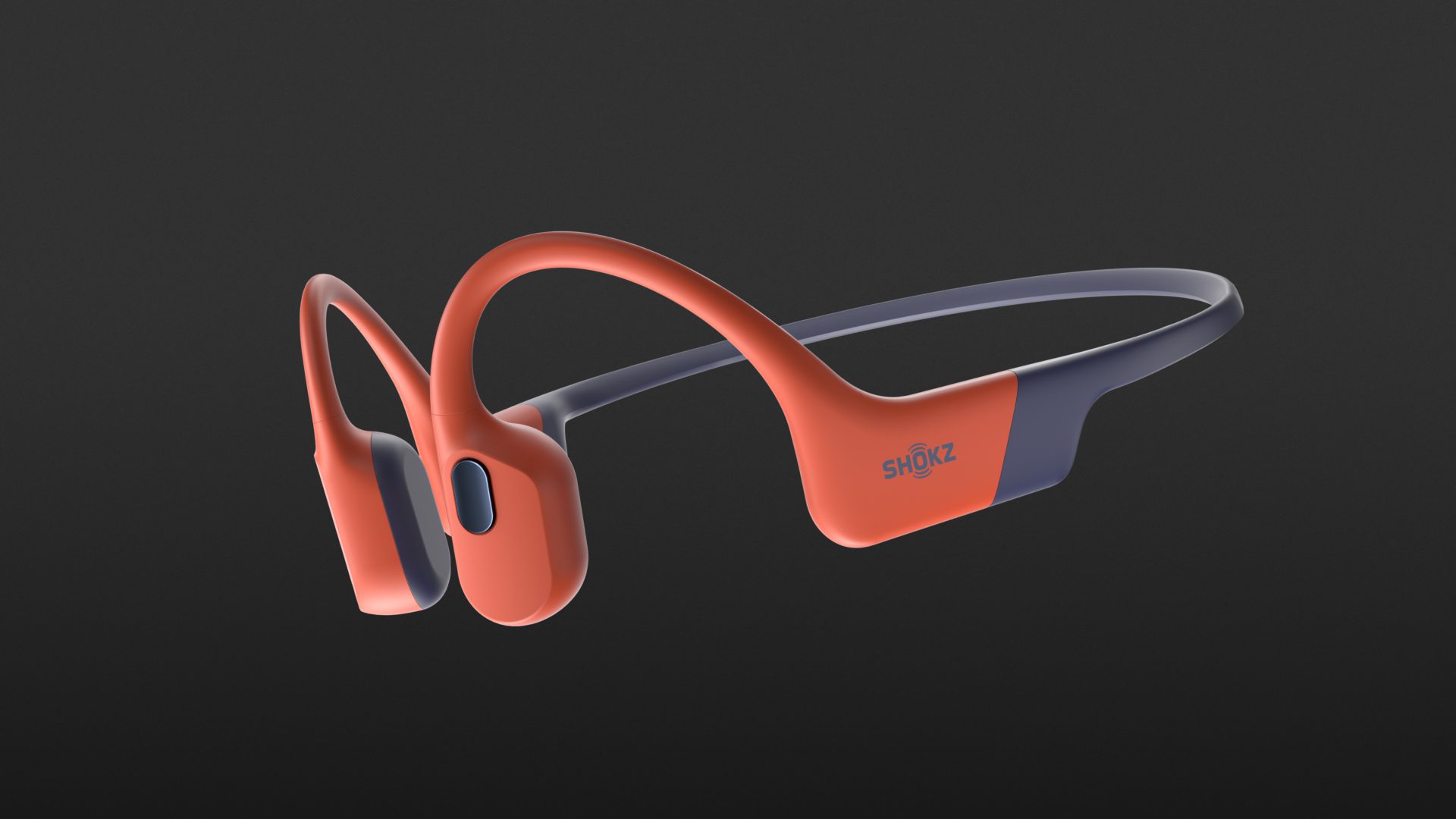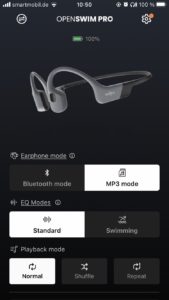The Shokz OpenSwim Pro is optimised for mobile use, especially for sports, and can be used not only on land but also in the water – thanks to the integrated MP3 player. It occupies its own segment in the market. It’s easy to forgive the bone conduction transducer for the fact that the sound quality can’t compete with conventional headphones. The open-ear system has a completely different focus, which in this case is combined with a high level of comfort.
- Sports headphones also suitable for swimming
- High level of comfort
- Open ear design for increased safety when used outdoors
- MP3 player with 32GB
- Missing control features when using MP3 player
- Hardly suitable for real music enjoyment
The Shokz OpenSwim Pro is a new bone conduction model from the Chinese sports headphones specialist. These are Bluetooth headphones designed specifically for athletes.
Like the existing Shokz OpenSwim, this waterproof (IP68) model can be used for water sports. An MP3 player, which has been expanded to a remarkable 32 GB compared to the standard model, is used to play music while swimming and snorkelling. Unlike its little brother, the Pro version can also be used conventionally ‘on land’ via Bluetooth 5.1. The open-ear design means you can run, walk, bike and do your daily workout in constant interaction with the world around you.
Design and features
Available in grey-black and red-black, the Shokz OpenSwim Pro weighs just 28 grams, is comfortable to wear thanks to its silicone coating and looks great. Technically, Shokz uses its own bone conduction technology, PremiumPitch 2.0+. The drivers sit on your cheekbones and transmit sound through them. The ear remains uncovered. This design provides increased safety and improved communication in mobile use.
Unlike the OpenRun Pro 2 (reviewed earlier), Shokz has not included an additional conventional driver, as this would not work well underwater – after all, the test device had to perform well in this medium.
As Bluetooth is not an option underwater, the Shokz OpenSwim Pro offers two modes of operation: regular mode and swim mode, in which music is played from the aforementioned built-in memory, which can be ‘filled’ with any audio file via USB. Shokz includes a special USB cable for this purpose, which can also be used for charging. The Bluetooth mode also allows you to switch between a neutral frequency response and a midrange-heavy mode for vocals. EQ switching, multi-pairing and firmware updates can all be done via the free Shokz app for iOS and Android.
The built-in battery lasts up to nine hours (Bluetooth) or six hours (MP3). It should be noted, however, that the headphones will typically be used at a fairly high level due to their open design. The battery life is certainly practical, even if it is not the best in its category. The charging time is 90 minutes. A quick-charge function is included, as is a standby function and an automatic switch-off after two hours. Otherwise, these headphones have to be switched on and off manually.
What are the advantages and disadvantages of bone conduction headphones?
Bone conduction headphones do not transmit sound to the inner ear like normal headphones, but via vibrations.
Practice
Comfort is optimal. The headband construction is stable and pressure-free, even when running. Operation is also straightforward: the Shokz OpenSwim Pro has two mechanical buttons on the right for volume control, which can also be used to turn the headphones on and off. On the outside of the left earbow, there is another mechanical button for further function control. Single, double and triple clicks, as well as longer presses, allow you to access and control music playback and the voice assistant.
You can also make a phone call and switch between Bluetooth and MP3 mode. Beeps and multilingual status announcements help the user. Finally, the Bluetooth connection was reliable and stable.
The voice quality during calls is good because the noise cancellation (ENS, DNS) works efficiently depending on the caller. However, the open design has the conceptual disadvantage that speech intelligibility always depends on the noise level in the environment. This means that calls on busy roads or public transport are severely limited. This is where the EQ setting, which focuses on voices, can help.
Added value: built-in MP3 player
With 32GB of storage space for audio files, the Shokz Open Swim Pro is generously equipped. According to the manufacturer, the memory can hold up to 8,000 songs, which is enough to get you across the Mediterranean. To load this memory, simply connect the headphones to your computer using the cable supplied. You can then use the drive that appears to load any tracks in popular formats such as MP3, WMA, WAV (up to 24 bits) and AAC.
However, there’s no real navigation on the headphones, apart from skipping tracks. You listen to tracks in linear or random order. This should be sufficient in most cases. However, in future the manufacturer should at least offer the option of switching between folders or prepared playlists on the device.
Sound
When it comes to sound quality, the Shokz OpenSwim Pro is in a class of its own. As an open system with bone conduction, it can hardly be compared to conventional headphones, so I will not deduct any points for limiting the audio codecs to SBC and AAC. In principle, the sound quality of bone conduction is surprisingly consistent, apart from the reduced bass, reduced transparency and the conceptually low signal-to-noise ratio.
This means that a fairly high base volume is required to achieve a sense of pressure and a certain sonority. Within these limits, I would describe the Shokz OpenSwim Pro as having a pleasant sound, as it is balanced in the mid-range and by no means nasal. In direct comparison to open-ear solutions such as the Shokz OpenFit, I feel that the bone conduction is at a disadvantage in terms of sound, although the hybrid Shokz OpenRun Pro 2 is probably the best solution currently available. With these features, the Shokz OpenSwim Pro in Bluetooth mode provides a fairly pleasant background sound when you’re on the move and exercising. However, it’s also clear that noisy environments can spoil this.
A clear selling point for the headphones is their ability to be used in water. Again, the basic sound quality is surprisingly balanced. However, the practical benefit of swimming turns out to be more of a gimmick. Why is that? You are constantly dipping your head under and out of the water, changing the ‘element’. And this change has a clear effect on the sound reproduction. The problem can be mitigated by wearing earplugs while swimming, but that’s not for everyone. In this respect, you should expect the OpenSwim Pro to provide a nice background sound even in this mode. However, if you like to swim alone, you are likely to make some nice acquaintances here.
The Verdict
The Shokz OpenSwim Pro is a specialist. You buy these headphones for use during sport. This is possible, with very pleasing results, as bone conduction delivers a surprisingly pleasant sound experience. Communication is not restricted and safety in traffic is guaranteed. They are also very comfortable to wear! An added bonus, or rather selling point, is that the OpenSwim Pro is also suitable for swimming and water sports. This is a clear added value for water enthusiasts. In this respect, the Pro version is a good choice for both ‘worlds’.
Technical specifications
What's in the box
- Swimming earplugs
- 4-pole magnetic charging cable
- Case made of silicone rubber
Special features
- Available in grey-black and red-black
- BT version: 5.4
- BT codecs: SBC, AAC
- BT profiles: A2DP, AVRCP, HFP













































We all know bone conduction headphones don’t produce audiophile quality sound. Focus on their functionality and they are great. Nobody wants earbuds when you’re doing sports, except in the gym.